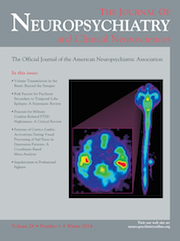A Case of Cotard Syndrome in a Woman With a Right Subdural Hemorrhage
To the Editor: Délire des négations (nihilistic syndrome) was first described in 1880 by Jules Cotard in a woman with a psychotic depression.1 Cotard syndrome is a rare neuropsychiatric condition involving the delusional belief that one has died or is dying, and it includes nihilistic thoughts of specific body parts or self-related themes. We present a case of Cotard syndrome after a spontaneous right frontoparietal subdural hemorrhage.
Case Report
A 73-year-old, right-handed, Caucasian woman with no previous neuropsychiatric history presented to a tertiary-care psychiatric emergency room insisting that she was “going to die and going to hell.” This belief started abruptly overnight when she woke her husband to express matter-of-factly that she had “gotten on in years” and her “time to pass away would arrive shortly.” This belief persisted for 48 hours, prompting a visit to the emergency room. On interview, she denied low mood or other symptoms of depression. She had no history of affective or psychotic disorders, head trauma, or seizures. Her medical history was notable for hypothyroidism and hypertension treated with levothyroxine 100 mcg and antihypertensive medications; she was not on antiplatelet medications. She had a family history of depression, with a maternal uncle who had committed suicide. Mental status examination revealed flat affect, linear thought process, and thought content notable for preoccupation with her impending death. She was alert and fully oriented. She correctly spelled “world” backward, and made one error in reciting the months of the year in reverse order. Repetition, naming, and expressive and receptive language were normal. Ideomotor praxis was intact. She registered 3/3 words and recalled 1/3 words in 5 minutes, and did not benefit from categorical prompts. Vital signs and neurological exam were unremarkable, including the absence of long track signs and a lack of extinction to double simultaneous visual or tactile stimulation. Laboratory studies showed normal electrolytes, blood counts, liver function, and coagulation profiles; thyroid stimulating hormone was 3.63 μU/ml. Head computed tomography (CT) revealed an acute-on-chronic, 12-mm right fronto-parietal subdural hemorrhage. Electroencephalography demonstrated near continuous theta slowing over the right hemisphere, maximal in the frontotemporal region, without epileptiform activity. She was started on levetiracetam 500 mg twice daily and admitted for 24 hours to the neurology inpatient ward. Follow-up CT was unchanged, and her nihilistic delusion resolved within 1 week.
Discussion
Cotard syndrome has been previously described in idiopathic psychiatric conditions including schizophrenia and psychotic depression2 and across neurologic disorders, including cerebral infarctions, traumatic brain injury, arteriovenous malformations, multiple sclerosis, and neurodegenerative diseases.3 This case highlights the finding that Cotard syndrome may present after subdural hemorrhage with disruption of nondominant fronto-parieto-temporal networks, consistent with previously-reported lesion sites.3,4 Right temporoparietal dysfunction has been implicated in disorders of corporeal awareness.5 Preserved left hemisphere-mediated interpreter functions, together with right-hemispheric dysfunction and frontal executive impairments, may contribute to the development of false nihilistic beliefs.
1 : Du délire hypocondriaque dans une forme grave de la melancolie anxieuse. Ann Med Psychol (Paris) 1880; 4:168–174Google Scholar
2 : Cotard syndrome in neurological and psychiatric patients. J Neuropsychiatry Clin Neurosci 2010; 22:409–416Link, Google Scholar
3 : An overview of the neurological correlates of Cotard syndrome. Eur J Psychiatry 2007; 21:99–116Google Scholar
4 : Cotard delusion after brain injury. Psychol Med 1992; 22:799–804Crossref, Medline, Google Scholar
5 : Right cerebral hemisphere dominance for a sense of corporeal and emotional self. Epilepsy Behav 2000; 1:60–73Crossref, Google Scholar



